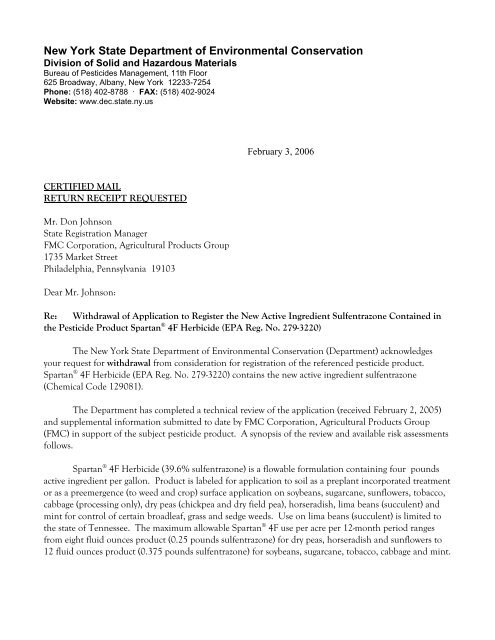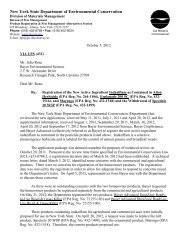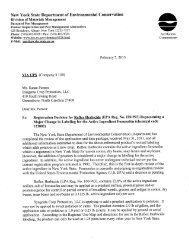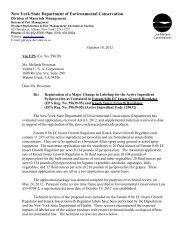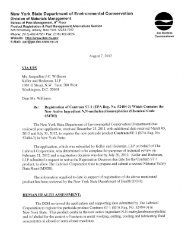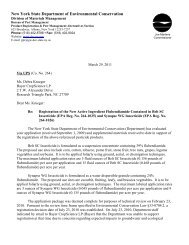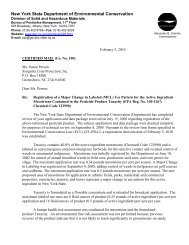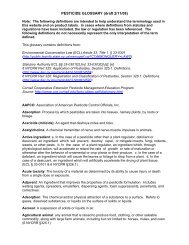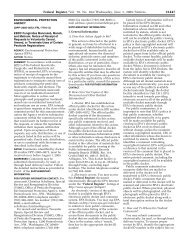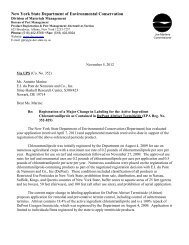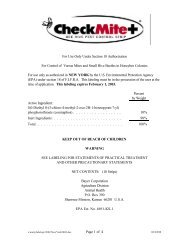New York State Department of Environmental ... - Cornell University
New York State Department of Environmental ... - Cornell University
New York State Department of Environmental ... - Cornell University
You also want an ePaper? Increase the reach of your titles
YUMPU automatically turns print PDFs into web optimized ePapers that Google loves.
<strong>New</strong> <strong>York</strong> <strong>State</strong> <strong>Department</strong> <strong>of</strong> <strong>Environmental</strong> Conservation<br />
Division <strong>of</strong> Solid and Hazardous Materials<br />
Bureau <strong>of</strong> Pesticides Management, 11th Floor<br />
625 Broadway, Albany, <strong>New</strong> <strong>York</strong> 12233-7254<br />
Phone: (518) 402-8788 · FAX: (518) 402-9024<br />
Website: www.dec.state.ny.us<br />
CERTIFIED MAIL<br />
RETURN RECEIPT REQUESTED<br />
Mr. Don Johnson<br />
<strong>State</strong> Registration Manager<br />
FMC Corporation, Agricultural Products Group<br />
1735 Market Street<br />
Philadelphia, Pennsylvania 19103<br />
Dear Mr. Johnson:<br />
February 3, 2006<br />
Re: Withdrawal <strong>of</strong> Application to Register the <strong>New</strong> Active Ingredient Sulfentrazone Contained in<br />
the Pesticide Product Spartan ® 4F Herbicide (EPA Reg. No. 279-3220)<br />
The <strong>New</strong> <strong>York</strong> <strong>State</strong> <strong>Department</strong> <strong>of</strong> <strong>Environmental</strong> Conservation (<strong>Department</strong>) acknowledges<br />
your request for withdrawal from consideration for registration <strong>of</strong> the referenced pesticide product.<br />
Spartan ® 4F Herbicide (EPA Reg. No. 279-3220) contains the new active ingredient sulfentrazone<br />
(Chemical Code 129081).<br />
The <strong>Department</strong> has completed a technical review <strong>of</strong> the application (received February 2, 2005)<br />
and supplemental information submitted to date by FMC Corporation, Agricultural Products Group<br />
(FMC) in support <strong>of</strong> the subject pesticide product. A synopsis <strong>of</strong> the review and available risk assessments<br />
follows.<br />
Spartan ® 4F Herbicide (39.6% sulfentrazone) is a flowable formulation containing four pounds<br />
active ingredient per gallon. Product is labeled for application to soil as a preplant incorporated treatment<br />
or as a preemergence (to weed and crop) surface application on soybeans, sugarcane, sunflowers, tobacco,<br />
cabbage (processing only), dry peas (chickpea and dry field pea), horseradish, lima beans (succulent) and<br />
mint for control <strong>of</strong> certain broadleaf, grass and sedge weeds. Use on lima beans (succulent) is limited to<br />
the state <strong>of</strong> Tennessee. The maximum allowable Spartan ® 4F use per acre per 12-month period ranges<br />
from eight fluid ounces product (0.25 pounds sulfentrazone) for dry peas, horseradish and sunflowers to<br />
12 fluid ounces product (0.375 pounds sulfentrazone) for soybeans, sugarcane, tobacco, cabbage and mint.
Mr. Don Johnson 2.<br />
The total allowed usage per 12-month period includes all applications made to the field per 12month<br />
interval. This includes fallow treatments, burndown treatments, planting time and all in-season<br />
treatments. The 12-month period is considered to begin upon the initial Spartan ® 4F Herbicide<br />
application.<br />
The subject application package was deemed complete for purposes <strong>of</strong> technical review on August<br />
24, 2005 following two determinations <strong>of</strong> incompleteness. Pursuant to the review time frame specified in<br />
<strong>Environmental</strong> Conservation Law (ECL) §33-0704.2, a registration decision date <strong>of</strong> January 21, 2006 was<br />
established.<br />
Health effects and environmental fate risk assessments were conducted for sulfentrazone and the<br />
Spartan ® 4F Herbicide formulated product. An ecotoxicity risk assessment was not produced for this<br />
product. Analytical methods for the determination <strong>of</strong> sulfentrazone in water and soil were deemed<br />
complete and acceptable following the receipt <strong>of</strong> additional information submitted on November 22,<br />
2005.<br />
HEALTH EFFECTS RISK ASSESSMENT: Neither the active ingredient sulfentrazone nor the<br />
formulated product Spartan ® 4F Herbicide was very toxic in acute oral, dermal or inhalation exposure<br />
studies in laboratory animals, nor were they very irritating to the eyes and skin (tested on rabbits). Also,<br />
neither material was a skin sensitizer (tested on guinea pigs).<br />
Sulfentrazone caused some toxicity in chronic animal feeding studies. In dogs, rats and mice,<br />
sulfentrazone caused hematological effects, characterized primarily by a decrease in hemoglobin levels, at<br />
doses <strong>of</strong> 61.2, 82.8 and 160.5 milligrams per kilogram body weight per day (mg/kg/day), respectively, in<br />
males, and 61.9, 67 and 198 mg/kg/day in females. The respective-no-observed-effect levels (NOELs) in<br />
male dogs, rats and mice were 24.9, 40 and 93.9 mg/kg/day, whereas in females, the respective NOELs<br />
were 29.6, 36.4 and 116.9 mg/kg/day.<br />
Sulfentrazone caused some developmental toxicity in the <strong>of</strong>fspring <strong>of</strong> pregnant rabbits and rats<br />
administered this compound during organogenesis. In a rabbit oral developmental toxicity study, an<br />
increase in fetal resorptions and decreases in live fetuses per litter and fetal weight occurred at a dose <strong>of</strong><br />
250 mg/kg/day; the NOEL was 100 mg/kg/day. In this study, maternal toxicity characterized by reduced<br />
body weight gain, was reported at a dose level <strong>of</strong> 250 mg/kg/day, with a NOEL <strong>of</strong> 100 mg/kg/day. In a<br />
rat oral developmental toxicity study, retarded fetal skeletal development and decreased fetal weight were<br />
observed at a dose <strong>of</strong> 25 mg/kg/day; the NOEL was ten mg/kg/day. Maternal toxicity, characterized by<br />
an increase in relative spleen weight and splenic extramedullary hematopoiesis, occurred at 50 mg/kg/day<br />
with a NOEL <strong>of</strong> 25 mg/kg/day. In another rat developmental toxicity study, but this time conducted by<br />
the dermal route <strong>of</strong> exposure, sulfentrazone caused an increase incidence <strong>of</strong> fetal abnormalities<br />
(incompletely ossified lumbar vertebral arches, hypoplastic or wavy ribs) at a dose <strong>of</strong> 250 mg/kg/day; the<br />
NOEL was 100 mg/kg/day. No maternal toxicity was observed at the highest dose tested, which was 250<br />
mg/kg/day. In a multigeneration reproduction study in rats, sulfentrazone caused an increased duration<br />
<strong>of</strong> gestation in both generations and testicular damage in the F1 generation at 40 and 33 mg/kg/day for<br />
females and males, respectively; the respective NOELs were 16 and 14 mg/kg/day. Parental toxicity which<br />
was characterized by a decrease in body weight gain and body weights was also observed at 33 and 40
Mr. Don Johnson 3.<br />
mg/kg/day for male and female animals respectively, with respective NOELs <strong>of</strong> 14 and 16 mg/kg/day.<br />
The United <strong>State</strong>s <strong>Environmental</strong> Protection Agency (USEPA) Office <strong>of</strong> Pesticide Programs established an<br />
oral reference dose (RfD) <strong>of</strong> 0.14 mg/kg/day based on a NOEL <strong>of</strong> 14 mg/kg/day from the<br />
multigeneration reproduction study in rats and an uncertainty factor <strong>of</strong> 100. This RfD has not yet been<br />
adopted by the USEPA’s Integrated Risk Information System (IRIS).<br />
Sulfentrazone did not cause oncogenic effects in either rat or mouse chronic feeding studies. In<br />
addition, genotoxicity studies on sulfentrazone gave negative results. Based on the lack <strong>of</strong> evidence for<br />
carcinogenicity in rats and mice, the USEPA classified sulfentrazone as “not likely to be carcinogenic to<br />
humans.”<br />
The USEPA established tolerances for sulfentrazone residues in or on soybeans at 0.05 parts per<br />
million (ppm); asparagus, lima beans, potatoes, peas/beans, each at 0.15 ppm; cabbage (0.20 ppm); and<br />
field corn (forage, grain and stover at 0.20, 0.15 and 0.30 ppm, respectively). The chronic population<br />
adjusted dose (cPAD) for sulfentrazone is 0.14 mg/kg/day and has the same basis as the RfD. The<br />
USEPA estimated that the chronic dietary exposure to sulfentrazone residues would be one percent <strong>of</strong> the<br />
cPAD for each <strong>of</strong> the following population subgroups: general U.S. population; infants less than one year<br />
old; children one to two years old; children three to five years old. This chronic exposure analysis is based<br />
on the conservative assumptions that 100% <strong>of</strong> the crops are treated and that these treated crops contain<br />
tolerance level residues.<br />
The USEPA conducted a risk assessment for dermal and inhalation exposure <strong>of</strong> workers to<br />
sulfentrazone from its use on turf grass, including golf courses, and a variety <strong>of</strong> crops for which tolerances<br />
have been established, as noted above. For mixers/loaders/applicators, the margins <strong>of</strong> exposure (MOEs)<br />
for dermal and inhalation exposures were estimated to range from 200 to 5,700 and 2,400 to 15,000,<br />
respectively, for use on crops. For use on turf, the estimated dermal and inhalation MOEs were 91,000<br />
and 187,000, respectively. For these estimates, it was assumed that workers wore a long-sleeved shirt, long<br />
pants, shoes and socks and gloves (the Spartan ® 4F Herbicide label requires the use <strong>of</strong> this personal<br />
protective equipment). The NOEL used for estimating the dermal MOE was 100 mg/kg/day from the<br />
dermal developmental toxicity study in rats, and for estimating the inhalation MOE, the NOEL used was<br />
14 mg/kg/day from the multigeneration reproduction study in rats. For post-application exposures <strong>of</strong><br />
workers to sulfentrazone-treated crops, the estimated MOE was 450. For golfers, the MOEs ranged from<br />
1,200,000 to 2,000,000, whereas for post-application exposures to sulfentrazone-treated residential lawns,<br />
the estimated MOE for adults was 12,000 and for children, estimated MOEs ranged from 8,500 to<br />
64,000. Generally, the USEPA considers MOEs <strong>of</strong> 100-fold or greater to provide adequate protection for<br />
workers, short-term nonworkers (e.g., golfers) and the general public.<br />
The <strong>New</strong> <strong>York</strong> <strong>State</strong> <strong>Department</strong> <strong>of</strong> Health (NYSDOH) briefly reviewed the environmental fate<br />
data for sulfentrazone. These data indicate that this chemical may have the ability to leach through<br />
certain soil types and contaminate groundwater; the adsorption coefficients (Koc) depending on soil type,<br />
ranged from 26 to 77. These values suggest that sulfentrazone has a high mobility through some soils. In<br />
addition, the Spartan ® 4F product label contains the groundwater advisory, “This chemical is known to<br />
leach through soil into groundwater under certain conditions as a result <strong>of</strong> label use. Use <strong>of</strong> this chemical<br />
in areas where soils are permeable, particularly where the water table is shallow, may result in
Mr. Don Johnson 4.<br />
groundwater contamination.”<br />
There are no chemical-specific federal or <strong>New</strong> <strong>York</strong> <strong>State</strong> drinking water/groundwater standards<br />
for sulfentrazone. Based on its chemical structure, this compound falls under the 50 microgram per liter<br />
<strong>New</strong> <strong>York</strong> <strong>State</strong> drinking water standard for “unspecified organic contaminants” (10 NYCRR Part 5,<br />
Public Water Systems).<br />
The available information on sulfentrazone and Spartan ® 4F Herbicide indicates that neither the<br />
active ingredient nor the formulated product was very acutely toxic, irritating or a sensitizer in laboratory<br />
animal studies. Furthermore, sulfentrazone was not carcinogenic in rats or mice. Although data from<br />
chronic and developmental/reproductive studies showed that this chemical has the potential to cause<br />
some toxicity, the estimated risks to workers from the use <strong>of</strong> the Spartan ® 4F product or to workers and<br />
the general public from post-application exposure to sulfentrazone are within the range that the USEPA<br />
generally considers acceptable. In addition, dietary exposure <strong>of</strong> the general public to sulfentrazone from<br />
currently labeled crops was determined by the USEPA to not pose significant health risks. Since there<br />
were clear NOELs/LOELs and the dietary exposure assessment has a reliable and conservative basis,<br />
USEPA did not include an additional uncertainty factor when deriving the cPAD to account for<br />
potentially greater fetal sensitivity. If an extra ten-fold uncertainty factor was incorporated in the cPAD,<br />
dietary exposure estimates would still not exceed this value, indicating acceptable risks.<br />
Given the above, NYSDOH did not object to the registration <strong>of</strong> Spartan ® 4F Herbicide on the<br />
basis <strong>of</strong> direct human health risks. Sulfentrazone, however, appears to have the potential to leach through<br />
soil and contaminate groundwater/drinking water.<br />
ECOLOGICAL EFFECTS RISK ASSESSMENT: The <strong>Department</strong>’s Bureau <strong>of</strong> Habitat had no basis to<br />
object to registration <strong>of</strong> Spartan ® 4F Herbicide, however, an ecological effects risk assessment was not<br />
completed for this product.<br />
ENVIRONMENTAL FATE RISK ASSESSMENT: Sulfentrazone is also referred to as<br />
methanesulfonamide or F6285 in the data package submitted for review.<br />
The application rate is based upon the soil texture (coarse, medium or fine) and the percent <strong>of</strong><br />
organic matter, with the higher application rates for fine soils and soils with >3% organic matter. The<br />
product is applied to the soil, and can be applied as preplant, preemergent, or post-plant treatment. The<br />
product requires moisture to be activated, or may be incorporated into the soil to be activated if no<br />
irrigation is present. The product is taken up by the germinating seeds and seedlings. The amount <strong>of</strong><br />
product available for uptake is determined by soil type, amount <strong>of</strong> organic matter and soil and irrigation<br />
water pH. Sulfentrazone adsorbs to clay and organic matter, and is thus not available for uptake. As soil<br />
pH decreases, the amount <strong>of</strong> product available for uptake decreases. Also, as the pH <strong>of</strong> the irrigation<br />
water decreases, the amount <strong>of</strong> sulfentrazone available for uptake increases.
Mr. Don Johnson 5.<br />
The following table shows the maximum allowable Spartan ® 4F use on soybeans per acre per 12month<br />
period based on soil texture and percent organic matter. Coarse soils are sand, loamy sand and<br />
sandy loam. Medium soils are sandy clay loam, sandy clay, loam, silt loam, and silt. Fine soils are silty clay<br />
loam, silty clay, clay loam and clay.<br />
% Organic<br />
Matter<br />
3<br />
Fluid Ounces <strong>of</strong> Product to be applied for Soybeans<br />
COARSE SOIL<br />
4.5-6.0<br />
6.0-8.0<br />
8.0-10.1<br />
Solubility: Sulfentrazone has a solubility <strong>of</strong> 780 mg/L.<br />
MEDIUM SOIL<br />
6.0-8.0<br />
8.0-10.1<br />
10.1-12.0<br />
FINE SOILS<br />
Hydrolysis: According to the June 16, 2003 EFED memorandum for Section 3 Registration,<br />
sulfentrazone is not susceptible to hydrolysis with half-lives <strong>of</strong> 143 days at pH 5; 207 to 375 days at pH 7;<br />
and 348 days at pH 9 in sterile buffered solutions.<br />
Aqueous Photolysis: In an acceptable study (MRID 42932117), sulfentrazone photodegraded with a halflife<br />
<strong>of</strong> 12 hours in pH 5, one hour in pH 7 and one hour in pH 9 sterile buffer solutions. Major<br />
degradates were found at pH 7; des-dichloromonohydroxy sulfentrazone at 12.8%; 2,4-dihydroxy<br />
sulfentrazone at 11.7%. Methyl triazole was the major degradation product, reaching 25.7% <strong>of</strong> the<br />
applied at the end <strong>of</strong> ten days exposure.<br />
Soil Photolysis: According to the June 16, 2003 EFED memorandum for Section 3 Registration,<br />
sulfentrazone is very stable to photolysis on sand and sandy loam soils with half-lives <strong>of</strong> 98 and 161,<br />
respectively.<br />
Aerobic Soil Metabolism: In an acceptable study (MRID 42932117), sulfentrazone degraded with a halflife<br />
<strong>of</strong> 535 to 555 days in a sandy loam soil (1.6% OM and pH 6.7) and 534 to 541 days in a silty clay<br />
loam soil (4.2% OM and pH 6.6). One major degradate was found, F6285 3-carboxylic acid at 10.8%.<br />
Anaerobic Aquatic Metabolism: In an acceptable study (MRID 43345426), sulfentrazone degraded very<br />
slowly in a flooded loamy sand sediment with an estimated half-life <strong>of</strong> nine years.<br />
Adsorption/Desorption: In a partially acceptable study (MRID 43355903), the DER states that<br />
radiolabeled sulfentrazone was mobile in columns <strong>of</strong> sandy loam. Two degradates were found, both<br />
minor, but USEPA indicated that they were very mobile. They were 3-hydroxymethyl F6285 and 3carboxylic<br />
acid F6285.<br />
8.0<br />
10.1<br />
12.0
Mr. Don Johnson 6.<br />
This study was scientifically sound but did not meet Subdivision N Guidelines (MRID 41911604).<br />
sandy loam<br />
silt loam<br />
silty clay loam<br />
sand<br />
%OM<br />
3.8<br />
5.9<br />
3.9<br />
0.4<br />
pH<br />
6.9<br />
7.1<br />
7.0<br />
6.0<br />
Koc adsorption<br />
29<br />
26<br />
40<br />
Koc desorption<br />
Terrestrial Field Dissipation: In an acceptable study (MRID43345427), sulfentrazone dissipated in the 0<br />
to six-inch layer <strong>of</strong> a bareground clay loam soil with a half-life <strong>of</strong> one year. Sulfentrazone was detected in<br />
the six- to 12-inch soil layer at four to nine ppb at 61 through 451 days and 20 ppb at 531 days. At all<br />
sampling intervals, sulfentrazone averaged
Mr. Don Johnson 7.<br />
Preliminary results from the three groundwater studies suggest that sulfentrazone and the acid degradate<br />
are very mobile.<br />
USEPA Comments: In a March 22, 1996 EF&GWB Memorandum, USEPA states:<br />
“No decision has been made at this time regarding what additional measures might be necessary to<br />
mitigate any potential for sulfentrazone use to contaminate groundwater. Recommendations will<br />
be made upon completion <strong>of</strong> the Agency’s review <strong>of</strong> the final report for the small-scale prospective<br />
groundwater monitoring study submitted by the registrant.”<br />
Modeling: The <strong>Department</strong>’s groundwater model (LEACHP) using Riverhead soil, a Koc <strong>of</strong> 29, a half-life<br />
<strong>of</strong> 535 days, and the maximum application rate <strong>of</strong> 0.375 lb ai/acre/year predicts breakthrough in four<br />
months and cyclical sulfentrazone concentrations ranging from 20 to 110 ppb over the ten-year modeling<br />
cycle.<br />
The <strong>Department</strong>’s groundwater model using Howard soil, a Koc <strong>of</strong> 40, a half-life <strong>of</strong> 534 days, and the<br />
maximum application rate <strong>of</strong> 0.375 lb ai/acre/year predicts breakthrough in year two and sulfentrazone<br />
concentrations ranging from 50 to 90 ppb over the ten-year modeling cycle.<br />
Label <strong>State</strong>ments: Spartan ® 4F Herbicide contains the following text under the <strong>Environmental</strong> Hazards<br />
section <strong>of</strong> label:<br />
Groundwater Advisory: This chemical is known to leach through soil into groundwater under<br />
certain conditions as a result <strong>of</strong> label use. Use <strong>of</strong> this chemical in areas where soils are permeable,<br />
particularly where the water table is shallow, may result in groundwater contamination. Do not<br />
use on coarse soils classified as sand, which have less than one percent organic matter.<br />
Surface Water Advisory: Sulfentrazone can contaminate surface water through spray drift. Under<br />
some conditions, sulfentrazone may also have a high potential for run<strong>of</strong>f into surface water<br />
(primarily via dissolution in run<strong>of</strong>f water), for several to many months post-application. These<br />
include poorly draining or wet soils with readily visible slopes toward adjacent surface waters,<br />
frequently flooded areas, areas overlying extremely shallow groundwater, areas with in-field canals<br />
or ditches that drain to surface water, areas not separated from adjacent surface waters with<br />
vegetated filter strips, and areas over-lying tile drainage systems that drain to surface waters.<br />
Given sulfentrazone’s long half-life, very low Kocs, the modeling projections and the ground and<br />
surface water advisories, it appears that use <strong>of</strong> Spartan ® 4F Herbicide as labeled will have a significant<br />
negative impact on water quality in <strong>New</strong> <strong>York</strong> <strong>State</strong>.<br />
DISCUSSION: After reviewing all the information submitted by FMC in support <strong>of</strong> registration <strong>of</strong> the<br />
referenced pesticide product, the <strong>Department</strong> has determined that use <strong>of</strong> Spartan ® 4F Herbicide as labeled<br />
would result in deterioration <strong>of</strong> groundwater/drinking water resources in <strong>New</strong> <strong>York</strong> <strong>State</strong>. Sulfentrazone<br />
has high leaching potential and the environmental fate data, preliminary small-scale prospective<br />
groundwater monitoring data, and LEACHP simulations confirm this chemical’s ability to leach in
Mr. Don Johnson 8.<br />
vulnerable and less vulnerable soils.<br />
Due to the above-mentioned concerns, FMC has requested withdrawal <strong>of</strong> the application to<br />
register Spartan ® 4F Herbicide (EPA Reg. No. 279-3220) in <strong>New</strong> <strong>York</strong> <strong>State</strong>.<br />
The <strong>Department</strong> is aware that FMC is currently conducting three small-scale prospective<br />
groundwater monitoring studies at three different sites classified as approximating a 95 th , 85 th and 75 th<br />
percentile vulnerability for potential groundwater contamination. FMC anticipates in the near future<br />
USEPA will allow termination <strong>of</strong> these studies so a final report can be written and submitted for review.<br />
Upon completion <strong>of</strong> USEPA’s review <strong>of</strong> these studies, FMC intends to submit a new application and fee<br />
for registration <strong>of</strong> Spartan ® 4F Herbicide (EPA Reg. No. 279-3220) in <strong>New</strong> <strong>York</strong> <strong>State</strong>. Please note that<br />
the application should be accompanied by USEPA’s review documents and any other information that<br />
would address the <strong>Department</strong>’s concerns regarding the leaching potential <strong>of</strong> sulfentrazone.<br />
You are reminded that any unregistered pesticide product may not be sold, <strong>of</strong>fered for sale,<br />
distributed, or used in <strong>New</strong> <strong>York</strong> <strong>State</strong>.<br />
Please contact Samuel Jackling, Chief <strong>of</strong> our Pesticide Product Registration Section, at (518) 402-<br />
8768, if you have any questions.<br />
Sincerely,<br />
Maureen P Serafini<br />
Maureen P. Serafini<br />
Director<br />
Bureau <strong>of</strong> Pesticides Management<br />
cc: N. Kim/D. Luttinger, NYS Dept. <strong>of</strong> Health<br />
R. Zimmerman/R. Mungari, NYS Dept. <strong>of</strong> Ag. & Markets<br />
W. Smith, <strong>Cornell</strong> <strong>University</strong>, PSUR


